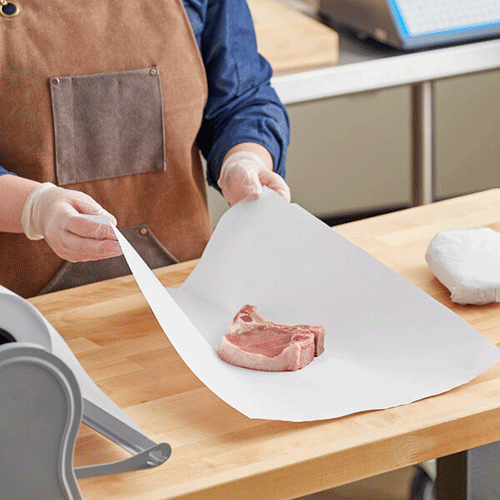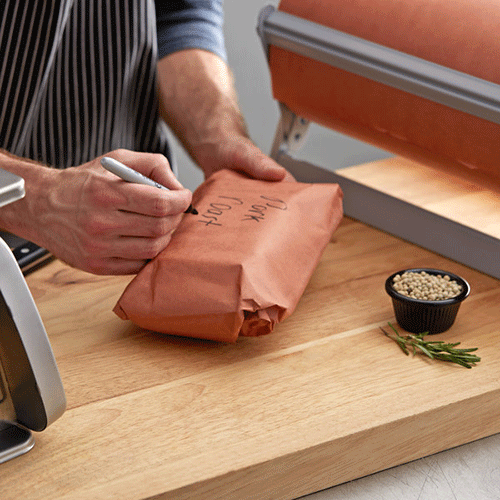Butcher paper is a special paper product designed for wrapping raw meats and fish to protect against airborne contaminants and flavor contamination. Also useful for cooking and preparing meat and packaging sandwiches and subs, butcher paper is available in a variety of colors and sizes to suit the unique needs of any business.
Whether you're starting a butcher shop, overseeing a deli, or selling your homemade sausages at a farmer's market, butcher paper is an essential tool for your business. Read on to learn about the different styles and features of butcher paper and its best applications.
Shop All Butcher PaperTypes of Butcher Paper

1. White Butcher Paper
White butcher paper is uncoated, FDA approved, and perfect for efficiently wrapping subs, sandwiches, meats, and more. Additionally, you can use white butcher paper as a table covering or to protect tabletops during arts and crafts activities. This breathable paper can be used to wrap meats before smoking because it allows the smoke in but doesn't trap moisture.
2. Pink / Peach Butcher Paper
Pink/peach butcher paper ranges in color from light tan to dark pink, which works well at masking any blood or juices from raw meats. The paper is strong enough to prevent leaks while still allowing the packaged meat to breathe, preventing sogginess. Peach butcher paper is ideal for wrapping meats for smoking because it allows the flavorful smoke to be absorbed while still protecting the meat from contaminants.
3. Peach Treated Butcher Paper
Peach-treated butcher paper looks very similar to the regular pink butcher paper described above, but it has a key difference. This premium paper is treated with a sizing agent that preserves fresh cut meats for storage. The treated paper allows just enough oxygen to reach the meat so that the meat stays fresh and its bright red color is preserved.
4. Gardenia Butcher Paper
Gardenia butcher paper is a premium, high-performance paper that offers superior protection and holdout against moisture. Often preferred over plastic packaging, Gardenia paper prevents the leaking of oil or juices but is also breathable to prevent sogginess. It has a unique color complementary to raw fish and poultry, which also quickly identifies it as Gardenia premium paper.
5. Steak Butcher Paper
Steak paper is commonly used to display beef and pork but works well as a backdrop to display any type of meat in butcher cases. Wrapping your meat in steak paper will seal in the product's juices while also preventing color loss, thereby allowing you to give customers a clean-looking and fresh product. This paper comes in a variety of sizes and colors, including green, black, white, and peach.
Butcher Paper Substitutes
If you forgot to place your online shipment order of restaurant supplies and are out of butcher paper, your operational continuity isn't in jeopardy. Below, we list some common kitchen supplies you can use as a butcher paper substitute until your next shipment arrives. We also explain how well these butcher paper substitutes work for cooking and merchandising your products.
- Freezer Paper - Freezer paper has a wax coating, so there is a concern that the wax coating could melt off and soil your meat in grilling and smoking applications. However, it is ideal for storing meats, particularly when freezing them.
- Parchment Paper - When grilling or smoking meat in parchment paper instead of butcher paper, place the meat over indirect heat and select an uncoated parchment paper. Parchment paper typically has a temperature rating of 400 degrees Fahrenheit.
- Foil - Foil can withstand high heat, so you can safely use it to grill or smoke proteins. The foil will help the meat stay extra juicy because no moisture will escape the foil, but the flavor of your meat bark will suffer.
- Plastic Wrap - If you need to wrap a sub sandwich or a customer's purchase of raw meat, plastic wrap can be used as a butcher paper substitute in a pinch. However, it must not be used in grilling or smoking applications.
- Baking Mats - Baking mats are breathable and withstand high heat, so you can wrap your meats in them before throwing them on a grill or in the smoker. They won't wrap larger cuts of meat, and juice is likely to escape since they were not created to fold.
- Paper Bags - Paper bags are the least durable butcher paper substitute, but you can use them for indirect heat cooking at a lower temperature or a quick smoking application if necessary. They'll certainly work for wrapping products for sale or storage, but they won't provide moisture resistance or guard against contaminants as well as butcher paper does.
Freezer Paper vs Butcher Paper
The fundamental difference between freezer paper and butcher paper is freezer paper has a polyethylene coating on one side that provides extra strength when it's exposed to moisture and protects against freezer burn. Freezer paper is usually more expensive than butcher paper, which lacks the polyethylene coating. You should not freeze food in any kind of non-freezer paper without first wrapping the product in plastic. Economical butcher paper is suitable for most non-freezer applications.
Butcher Paper vs Parchment Paper
Butcher paper and parchment paper have different thicknesses, surfaces, and degrees of moisture resistance. Parchment paper has a silicone coating to create a nonstick surface, making it ideal for lining baking sheets to prevent food from sticking to the pan, cooking unevenly, or burning while it bakes. You can use parchment paper instead of butcher paper in a pinch. However, it is not as ideal for wrapping meats or subs as butcher paper because it is thinner and not as moisture resistant.
How to Use Butcher Paper

Butcher paper is a multi-functional kitchen tool. Discover its most common uses below:
- Meat Prep - Wrap your meat in peach butcher paper while it brines. Use butcher paper as a seasoning surface. Rest meat in butcher paper after it cooks to hold the heat and preserve tenderness.
- Serving Customers - Wrap cuts of meat from your deli in butcher paper for customers to take home. Secure subs in butcher paper for them to enjoy on the go. Prevent moist sandwiches from falling apart in customers' hands by wrapping them in butcher paper.
- Cooking Meats - Fold butcher paper into pouches to steam delicate seafood inside. Secure tough briskets and pork shoulders in butcher paper before smoking them. Before grilling steaks and chicken breasts, wrap them in butcher paper.
Can You Put Butcher Paper in the Oven?
Thanks to its high heat resistance and strength, you can put butcher paper in the oven.
What Is Butcher Paper Coated With?
All butcher paper (with the exceptions of white butcher paper, pink butcher paper, and wider rolls) is coated with a material called sizing, which is chemical-free and designed to provide leak resistance and strength when wet. Larger rolls, such as 24", 30", and 36" widths are generally left untreated because they are traditionally used for crafts or table covers.
Gardenia paper features a proprietary coating that allows some fluids and air to penetrate the surface, preventing the occurrence of sliming. Sliming happens when meats or fish are wrapped tightly and sit in their juices with no breathability.
What Is the Basis Weight of Butcher Paper?
The basis weight of butcher paper is 40 #. Freezer paper's basis weight varies.
What Is Basis Weight?
Basis weight is the weight of one ream of paper (500 sheets) when cut to its industry-standard size. The higher the basis weight, the heavier the paper. Basis weight may differ from the actual weight of the product being sold, so we often denote basis weight with a "#" sign instead of the traditional "lb." designation.
Can I Write on Butcher Paper?
You can write on butcher paper with markers, pens, pencils, or chalk. However, keep in mind that you can only write on the outside of the paper due to its interior sizing or polyethylene coating.
With the wide variety of options available, choosing the perfect butcher paper for the unique needs of your business can be confusing. Whether you run a BBQ restaurant, sandwich stand, or fish market, knowing the differences between various kinds of butcher paper is an important part of safely packaging and storing meats, subs, and seafood.



